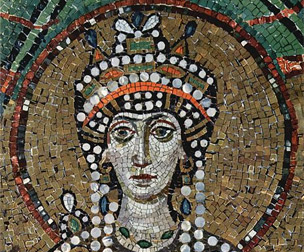
Theodora, I
"We have created authorities to punish thieves and robbers. Surely we have an even greater right to persecute those villains who commit crimes against the innocent?"
Date of Birth: 500
Place of Birth: Constantinople
Date of Death: 28/06/548 548
Place of Death: Constantinople
Burial Site: Church of the Apostles, Constantinople
Field of Activity
Cultural Patron
Founder of the first home for female artists in need.
On the Asian side of the Bosporus Theodora I built a home for female artists in need with a capacity for 500 beds. It was called Metanoia (Rethinking, Changing one's Outlook, Reversing one's Way of Thinking). This home was the first ever of its kind to be established specially for female artists.
Theodora I as a female legislator
Theodora I introduced new laws concerning adultery and divorce and supported maltreated wives with the edicts 117 and 134. She helped prostitutes and female comedians in distress and founded orphanages and hospitals. In one law it says: "We have created authorities to punish thieves and robbers. Surely we have an even greater right to persecute those villains who commit crimes against the innocent?"
As a result of Theodora's initiative, Justinian I enacted laws against the white slave trade and made pimping a punishable offence. Another consequence of Theodora's initiative was that for the first time in the history of the Byzantine Empire sons and daughters were guaranteed the same right of inheritance.
Awards
Memberships
Education
Contributions to Society
See Field of Activity
Family and Friends
- Mother:(Name no available, actress)
- Father: Akaios, bear keeper
- Son: Johannes
- Sisters: Komito, Anastasia
- Niece: Sophia (von 565 to 578 Roman Empress, wife of Justin II)
- Husband: Justinian I (Byzantine Emperor from 527 to 565)
Commemorative Projects
Further Reading
- Helga Lampe, "Theodora", erf.de.15.2.2012, http://www.erf.de/4760-542-3922-Artikel.html?PHPSESSID=gdknisil
- Procopius, The Secret History. http://www.fordham.edu/halsall/basis/procop-anec.asp
- John Johnson Lewis, "Theodora", womenshistory.about.com, http://womenshistory.about.com/od/medbyzantempress/a/theodora.htm
- Rigobert Günther, Römische Kaiserinnen. Zwischen Liebe, Macht und Religion, Militzke Verlag, Leipzig, 2003, S. 18.
- Bridge Anthony, Theodora. Aufstieg und Herrschaft einer byzantinischen Kaiserin, Heinrich Hugendubel Verlag, Kreuzlingen/München, 1999.
- Lynda Garland, Byzantine Empresses: Women and Power in Byzantium AD 527 - 1204. 1999.
- Andreas Thiele, Erzählende genealogische Stammtafeln zur europäischen Geschichte, Band III Europäische Kaiser-, Königs- und Fürstenhäuser Ergänzungsband, R.G. Fischer Verlag 1994.
- Edith Ennen, Frauen im Mittelalter, Verlag C.H. Beck, München, 1994, ss. 33-34 .
- Anthony Bridge, Theodora: Portrait in a Byzantine Landscape, 1993.
- Lieselotte von Eltz-Hoffmann, Frauen der frühen Kirche, 1991.
- Bertelsmann Lexikon Geschichte, 1991, s. 751.
- Lexikon Alte Kulturen, Meyers Lexikonverlag, Mannheim/Wien/Zürich, 1990, Band III, Seite 513.
- Robert Browning, Justinian und Theodora. Herrscher in Byzanz, Manfred Pawlak Verlagsgesellschaft mbH, Herrsching 1988, s. 52 .
- Grosse Frauen der Weltgeschichte. Tausend Biographien in Wort und Bild, Neuer Kaiser Verlag, 1987, s. 462 .
- Robert. Browning, Justinian and Theodora, 1987.
- Golo Mann, Propyläen Weltgeschichte. Eine Universalgeschichte, Vierter Band, Rom Die römische Welt, Verlag Ullstein GmbH, Frankfurt am Main - Berlin, Propyläen Verlag, 1986 s. 618.
- Robert Browning, Byzanz. Roms goldene Töchter: Die Geschichte des Byzantinischen Weltreiches, Gustav Lübbe Verlag GmbH, Bergisch Gladbach, 1982, s. 40.
- Charles Diehl, Theodora: Empress of Byzantium, 1972.
- Jean Steiner, Theodora. Von der Zirkusdirne zur Kaiserin, Editions Rencontre Lausanne 1970.
- Gerhard Löwe, Heinrich Alexander Stoll, Die Antike in Stichworten, Koehler & Amelung, Leipzig, 1967, Seite 325.
- Johannes Leipoldt, Die Frau in der Antike und im Urchristentum, 1962.
- Thiess Frank, Die griechischen Kaiser. Die Geburt Europas, Paul ZsolnayVerlags Gesellschaft mbH, Hamburg/Wien, 1959, ss. 41,43,64,166,358,465 .
- Clara Underhill, Theodora: The Courtesan of Constantinople. 1932.
- W. G. Holmes, The Age of Justinian and Theodora, 1912, 2 volumes.
Sources
Quoted sources
- See the "Further Reading" section
- Anette Kuhn (Ed), Die Chronik der Frauen, Dortmund, 1992, s. 145.
- Helga Lampe, "Theodora", erf.de.15.2.2012, http://www.erf.de/4760-542-3922-Artikel.html?PHPSESSID=gdknisil(1.5.2012)
Source for visual images
Addditional Note
Church of the Apostles, Constantinople
After Hagia Sophia the Church of the Apostles was the most important of the large churches of the East Roman Empire. It served as a burial church for the Byzantine rulers. The Cathedral of St. Mark's in Venice was modelled on the Church of the Apostles in its construction and thereby gives us a rough idea of what the church must have looked like. Today the Fatih-Mosque stands on the site of the Church of the Apostles.
Translation into English: Mary Waegner, Fürth, Bavaria, Germany ©2012 Meral Akkent



